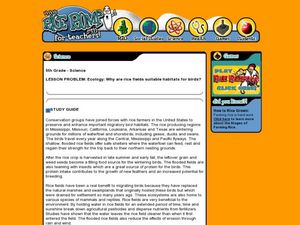Curated OER
Developing Civilizations and the Role of Rice
Student investigate how civilizations developed. In this rice farming lesson, 5th graders explore how rice cultivation changed through different civilizations. Students gain knowledge about different types of rice, where it's grown and...
Curated OER
What are rice farmers doing to help the environment with their water-filled rice fields?
Third graders research rice fields. In this rice fields instructional activity, 3rd graders discuss how fields contribute to the environment by providing an important food source for birds. They find the benefits of rice fields to water...
Curated OER
Ecology: Why Are Rice Fields Suitable Habitats for Birds?
Fifth graders discover the uses for rice by reading about the habitats of certain birds. In this agriculture lesson, 5th graders research birds from the Gulf Coast and California and their reasons for living in rice fields. Students...
Curated OER
Butterfly migration
In this butterfly migration worksheet, students complete multiple choice questions about the ways butterflies migrate. Students complete 5 questions total.
Curated OER
Measurement Review
Students measure the distance between two points. In this measurements instructional activity, students read books about birds that migrate and measure the distances that each bird flies when it migrates. Students discuss the...
Curated OER
What Drives Immigration?
Students research the primary causes of emigration and examine the affects of immigration on a country. They conduct research either individually or as a group and prepare a written report or dramatic presentation of their findings.
Curated OER
Hopskotch Migration
Students understand the use of the wetlands by migrating birds and identify causes for disappearance of the wetlands.
Curated OER
Tick-Tock: Biological Clock
Students complete several activities that stimulate their assessment of time. They consider the term 'biological clock' and how animals in the wild depend on their own internal clocks for survival.
Curated OER
Migration: A Dangerous Journey
Fourth graders pretend as if they're a whooping crane flying north for its migration. They write questions and predictions about what they are doing and what happen.
Curated OER
Hopscotch Migration
Students examine the use of wetlands by migrating birds. They discuss reasons for the disappearance of wetlands. They discover how humans have affected wetlands as well.
Curated OER
Marine Animals on the Move
Students complete a project based on collecting satellite data aimed at finding connections between organisms and the environment. They create a final project working with a partner to share with the class.
Curated OER
Heroes and Heroines of the Underground Railroad System (UGRR)
Fourth graders choose one leader, either Tubman or Coffin, and write a persuasive summary paragraph that explains why the leader displays the character traits of a hero/heroine in the UGRR
Curated OER
Lesson 6: Native Americans in the West
Students recall their knowledge of Native American people who lived in the West and reflect on how their perspectives differed from pioneers and argonauts of the 19th century.
Curated OER
It's Not My Problem!
Students examine how rivers flow through the country to sea level. Students study how upstream pollution effects the water and people downstream.
Curated OER
Water Quality and Temperature
Students are led through three activities to explore the effect of temperature fluctuations on the growth and survival of aquatic plants, clams, and shrimp eggs.
Curated OER
Motte Rimrock Reserve: Lesson Plan for Flora
Students study the flora of Motte Rimrock Reserve while observing organisms in their natural environment. They use a dichotomous key to identify plants.
Curated OER
Past v. Present: Using Geography & Anthropology
Students examine artifacts and documents from their Canadian community. They analyze early Canadian history and make predictions about the future of the country.
Curated OER
The Magic School Bus Goes Upstream
Students participate in an experiment that shows them how to use their senses to find their way "home." This experiment is based on the video that shows how salmon find their way to their home stream.
Curated OER
Survival in the Open Ocean
Students examine how scientists conduct pelagic research and identify pelagic predators as they study the open-ocean ecosystem. They discuss and conduct small group research of this environment in order to produce a presentation.
Curated OER
Global Awareness
High schoolers read about how scientists are arriving at current theories of human origin and migration through mitochondrial DNA analysis. They then piece together a map showing the data from mitochondrial DNA analysis to plot the...
Curated OER
Yearly Place Based theme
Students are awaken to their surroundings. They gain a greater access of how their city was formed. Students assess the human impact on the land. They comprehend the cultural diversity of the city.
Curated OER
What is Migration
Learners conduct individual research and participate in discussion be able to identify difference between forced and voluntary migration. They identify if push and pull factors are caused by political, social, economic, or environmental...
Curated OER
An Introduction to Brine Shrimp
Second graders engage in a instructional activity that seeks to discover information about Brine Shrimp. They conduct research using a variety of print and electronic resources. Students study the type of environment the shrimp need and...
Curated OER
Introduction To Brine Shrimp
Fourth graders engage in a variety of activities in order to find information about the brine shrimp. The lesson includes background information for the teacher to deliver instruction. They make observations of the shrimp in different...
Other popular searches
- Migratory Birds
- Migratory Patterns
- Migratory Species
- Migratory Birds Ducks Art
- Migratory Animals
- Map of Migratory Birds
- Migratory Paths of Butterflies
- Nontropical Migratory Birds
- Migratory Maps
- Neotropical Migratory Birds

























